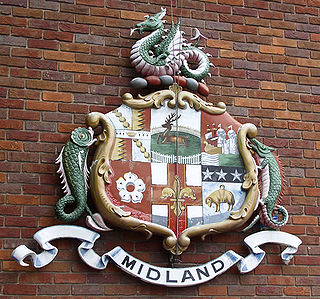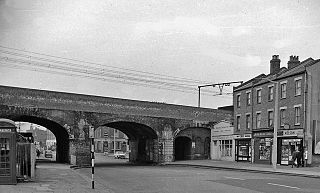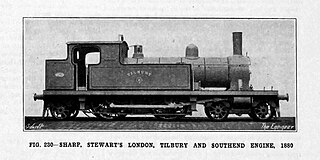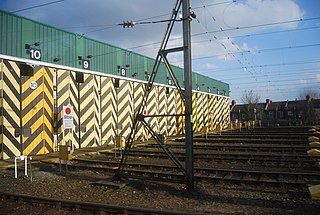
Limehouse is a National Rail and connected Docklands Light Railway (DLR) station in Limehouse, London, England. It is served by regional services operated by c2c to and from Fenchurch Street, and by light metro services provided by the DLR to and from Tower Gateway or Bank. On the main line, Limehouse is located 1 mile 58 chains (2.8 km) from Fenchurch Street and the following station is West Ham; on the DLR it is between Shadwell and Westferry in Travelcard Zone 2.

Fenchurch Street railway station, also known as London Fenchurch Street, is a central London railway terminus in the southeastern corner of the City of London. It takes its name from its proximity to Fenchurch Street, a key thoroughfare in the City. The station and all trains are operated by c2c. Services run on lines built by the London and Blackwall Railway (L&BR) and the London, Tilbury and Southend Railway (LTSR) are to destinations in east London and south Essex, including Upminster, Grays, Basildon, Southend and Shoeburyness.

The Locomotives of the Midland Railway, followed its small engine policy. The policy was later adopted by the London, Midland and Scottish Railway, and contrasted with the London and North Western Railway's policy. The small engine policy was partly the consequence of a difference in the background of senior managers. In most railway companies, the elite position was the design, construction and maintenance of locomotives. Bigger engines brought more prestige and allowed longer trains. In the Midland, the marketing department was paramount. They recognised that people wanted more frequent, shorter trains rather than an infrequent service. It concentrated on very light, very fast and frequent trains.

The London, Tilbury and Southend line, also known as Essex Thameside, is a commuter railway line on the British railway system. It connects Fenchurch Street station, in central London, with destinations in east London and Essex, including Barking, Upminster, Basildon, Grays, Tilbury, Southend and Shoeburyness.
Robert John "Bob" Essery was a British railway modeller and historian with a particular interest in the London Midland and Scottish Railway (LMS) and one of its principal constituents, the Midland Railway (MR).

The Midland Railway (MR) 2441 Class was a class of 0-6-0T steam locomotives. They were introduced by Samuel Johnson in 1899, originally with round-topped fireboxes. Henry Fowler later rebuilt them with Belpaire fireboxes. They were given the power classification 3F. The LMS Fowler Class 3F of 1924 was based on this design.

The Midland Railway 115 Class was the third of four classes of 4-2-2 steam locomotive, nicknamed "Spinners", designed by Samuel Waite Johnson. A total of 15 of the class were built between 1896 and 1899. They were capable of reaching speeds of up to 90 miles per hour (145 km/h). One engine, No. 673, is preserved in the National Collection.

Burdett Road is a disused railway station located in Bow Common, east London. It was opened in 1871 by the Great Eastern Railway and closed in 1941.

The London, Tilbury and Southend Railway (LTSR) 79 Class is a class of 4-4-2T suburban tank engines. They were designed by Thomas Whitelegg, as a development of the earlier 37 Class. They could reach a top speed of 65 mph.

The London, Tilbury and Southend Railway 51 class was a class of 4-4-2T steam locomotives. Twelve were built by Sharp, Stewart and Company to the design of Thomas Whitelegg for the London, Tilbury and Southend Railway in 1900, with North British Locomotive Company supplying an additional six in 1903. The LTSR numbered them 51–68, and named them places in London and Essex.

The London, Tilbury and Southend Railway (LT&SR) 2100 Class was a class of 4-6-4T steam locomotives. Eight were built in 1912, the year the Midland Railway took over the LT&SR, to the design of Robert Harben Whitelegg. Hence, they were numbered in the Midland numbering system as 2100–2107, and none received a name. The Midland gave them the power classification 3P. All subsequently passed into LMS ownership in 1923. They were all withdrawn 1929–1934, and all were scrapped.

The LT&SR 69 class was a class of 0-6-2T steam locomotives designed for freight work on the London, Tilbury and Southend Railway. Six were initially built in 1903 to the design of Thomas Whitelegg, four more followed in 1908, and a further four in 1912, after the LT&SR's takeover by the Midland Railway (MR) in that year, giving a total of 14. The Midland renumbered them 2180–2193, and all entered LMS stock upon the grouping of 1923. The LMS renumbered them 2220–2233 in 1923, but then took them back to 2180–2193 in 1939. In 1947 they were again renumbered 1980–1993 by the LMS, and in 1948 all were acquired by British Railways. BR added 40000 to their numbers so they became 41980–41993. Withdrawals started in 1958, and by 1959 all but 41981 had gone. The last engine was withdrawn in 1962, and none of the small fleet were preserved.
The LT&SR 49 class was a class of 0-6-0 steam locomotives. They were the only tender engines used by the London, Tilbury and Southend Railway. They were originally ordered by the Ottoman Railway in Turkey, however that order was cancelled after they had been built and instead they were sold to the LT&SR in 1898. The LT&SR numbered them 49 and 50.

The Midland Railway 1252 class was a class of thirty 0-4-4T locomotives built by Neilson and Company in 1875–1876 to the design of Samuel Waite Johnson. They were a development of the 6 Class. Originally numbers 1262–1281 and 1252–1261. Under the Midland Railway's 1907 renumbering scheme they became 1236–1265.

The LTSR 37 class was a class of 4-4-2T suburban tank engines built for the London, Tilbury and Southend Railway in 1897–98. They were designed by Thomas Whitelegg as a development of the earlier LT&SR 1 Class.

The London, Tilbury and Southend Railway 1 class was a class of 4-4-2T suburban tank engines. Thirty-six were built between 1880–1892, by Sharp, Stewart and Company and Nasmyth, Wilson and Company. They were the first locomotives owned by the London, Tilbury and Southend Railway and were the first 4-4-2T locomotives to operate in Britain.

East Ham Depot is a depot on the London, Tilbury and Southend line between East Ham and Barking stations with the depot code EM. The depot is approximately 6+1⁄2 mi (10.5 km) from London Fenchurch Street station, and just west of the River Roding.

The Midland Railway Class 3 4-4-0 was a series of 80 steam engines built by the Midland railway at the Derby locomotive works between 1900 and 1905.
The London, Tilbury and Southend Railway (LT&SR), was a British railway company, whose network connected Fenchurch Street station, in central London, with destinations in east London and Essex, including Barking, Upminster, Grays, Tilbury, Southend and Shoeburyness. The company and its assets were sold to the Midland Railway in 1912. The network over which they operated is largely intact and is currently operated as part of the Essex Thameside franchise.
The Glasgow and South Western Railway 540 Class were 4-6-4T steam tank locomotives designed by Robert Whitelegg and built in 1922, shortly before the G&SWR was absorbed into the London, Midland and Scottish Railway (LMS). They were referred to in official G&SWR publicity as the Baltic Class, although they were also known more prosaically to enginemen as the 'Big Pugs'.

















